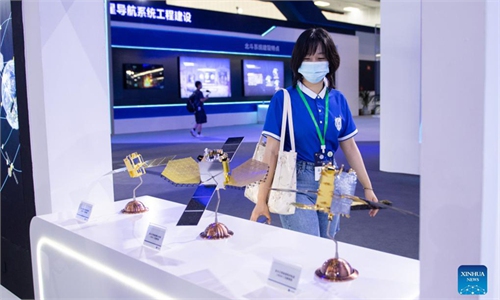
People visit the first International Summit on BeiDou Navigation Satellite System (BDS) Applications, in Changsha, central China's Hunan Province, Sept. 16, 2021. The First International Summit on BDS Applications opened Thursday with the theme "BDS serves the world, application fuels the future." Photo:Xinhua
The output value of China's satellite navigation and location services industry totaled 469 billion yuan ($69 billion) in 2021, up 16.3 percent from 2020, with the digital economy in particular accelerating the integration of the country's domestically developed BeiDou Satellite Navigation System (BDS) into the construction of electricity, agricultural and other types of infrastructure projects, a white paper said on Wednesday.
The total number of enterprises and public institutions within the field in China stands at around 14,000, employing more than 500,000 people, according to the white paper released by the GNSS & LBS Association of China (GLAC).
Within the industry, the output value of the sector, including microchips, algorithms, software, navigational data and infrastructure, which directly relate to the research and development (R&D) and application of satellite navigation technology, increased by 12.28 percent year-on-year to 145.4 billion yuan.
Related output value derived from satellite navigation applications and services increased by 18.2 percent year-on-year to 323.6 billion yuan, accounting for 69 percent of the total output value.
China's capacity for independent innovation in satellite navigation and location services has continued to improve. In 2021, the total number of related patent applications in China exceeded 98,000, maintaining its status as a global frontrunner, GLAC said.
The BDS is also becoming a standard feature for mass consumer products such as smartphones and wearable devices, with many domestic brands like Huawei, OPPO, VIVO and Xiaomi all using BDS applications.
In 2021, the number of domestically delivered smartphones supporting BDS reached 324 million, accounting for 94.5 percent of total domestic smartphone shipments, according to China's National Development and Reform Commission.
Per the white paper, a mobile phone equipped with the radio determination satellite service (RDSS) of BDS-3 will be launched soon, which will redefine the function of mobile applications.
RDSS' function, simply speaking, is two-way information sending and receiving through the BDS in the absence of a communication network, which is an exclusive "unique skill" of the BDS.
The BDS has gradually gained rising applications and large-scale deployment in the transportation, public safety and agriculture industries, as well as in infrastructure areas, including electricity and water conservation. It is facilitating growth of various industries and realizing remarkable benefits, the white paper said.


